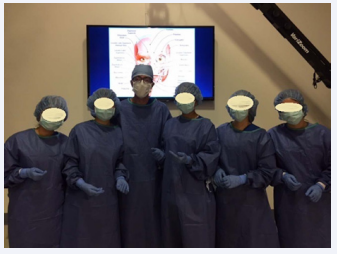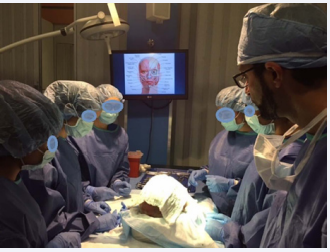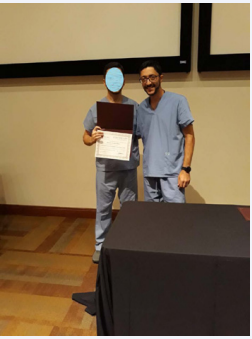Internationalization in Teaching Anatomy
- 1. Morphofunctional Laboratory, University of Franca, Brazil
- 2. peratory Technique Laboratory, University of Franca, Brazil
- 3. General Coordination, University of Franca, Brazil
Citation
Rasheed A, Hina M, Tafweez R (2019) Morphometric Measurements of Supraorbital and Infraorbital Foramen in Dry Skulls of Local Population. JSM Anat Physiol 4(1): 1021.
Abstract
International mobility during graduation includes advanced skills and attitudes. The shortage of cadavers for dissection is a reality, especially in new medical courses. The use of fresh frozen cadavers is a reality in many countries and allows the students’ contact with a model next to the reality. The objective of this study was to report the experience of internationalization through courses in a cadaver lab as a complementary pedagogical tool in the teaching of anatomy. The course was performed at the Miami Anatomical Research Center Institute, with prior submission of theoretical material. A “hands-on” modality was adopted, and all of the dissections were guided by a preceptor. At the end of each period, the group discussed all of the day activities, and at the end of the course a total review was done. The previous discussion of the theoretical material allowed us to ask questions and consolidate knowledge. The review of the instruments and biosafety concepts contributed to the better knowledge of the dynamics of a cadaver lab. The quality of the anatomical material was excellent, ensuring the visualization of delicate structures, as well as the more robust structures, allowing the integration of the same ones. The result of the activities was quite interesting and fulfilled with its purpose. Access to fresh frozen cadavers was a good opportunity to complement teaching and learning anatomy, allowing students to contact human material in a scenario close to reality, as well as developing skills for dissection and teamwork.
Keywords
Anatomy; Medical Education; Cadaver; International Educational Exchange; Anatomy teaching
Citation
Jardini Barbosa MV, de Souza J. Barbosa AM, Duarte SG (200) Internationalization in Teaching Anatomy – An Important Step to Start a Reflexive-Critical View on Medical Education. JSM Anat Physiol 5(1): 1022.
ABBREVIATIONS
MARC: Miami Anatomical Research Center
INTRODUCTION
The context of the globalized world has shortened distances and brought new perspectives of interconnectivity between educational institutions, aiming at cooperation in the exchange of information, providing students with experiences that improve skills and attitudes [1]. The opportunity to interact with new people and cultures through an international exchange gives the student a different and broader experience of the educational context, allowing a critical and reflective view on teaching, innovation and research in different contexts [2].
The use of dissected cadavers or their parts has been the oldest anatomy teaching tool and is still used today [3]. However, the scarcity of cadavers for study, either by reducing the number of donations or for ethical and legal reasons, is extremely relevant, especially for new medical courses, since availability is always less than demand [4]. When it comes to the use of non-fixed corpses, the difficulties are even greater, being almost impossible in Brazil.
On the other hand, the practice of living body donation for post-mortem studies is a reality in many countries [5]. In the United States of America and in some European countries there are institutions that provide cadaver laboratories, where teachingand research activities can be organized in frozen specimens and thus allow students to contact a model close to reality, being a complementary tool for teaching anatomy.
Although there are currently different opinions on the need for the use of cadavers to teach anatomy, most authors emphasize that their handling is important not only from the point of view of technical learning[6,7], but also from the point of view of ethicalhumanistic view insofar as the corpse should not be seen as a mere object of study [4].
Because of its importance, it is believed that it is the role of universities to provide complementary pedagogical tools that enable students to gain a broad view of anatomy teaching, including internationalization through short or long-term courses at partner institutions.
PURPOSE
The aim of the present study is to relate the internationalization experience through short courses in a cadaver lab, as a complementary pedagogical tool in the teaching of anatomy.
METHODS
This is a descriptive study that reports the teaching experience in the coordination and execution of three international anatomy courses, taught in Miami (Florida, United States of America).
COURSE ORGANIZATION
The idea of organizing an international course arose from an institutional agreement between the Cruzeiro Educational Group and the Miami Anatomical Research Center (M.A.R.C.) Institute. Initially, it was informed that the local structure allows the execution of theoretical activities (with availability of auditorium and meeting room) and practical activities, in addition to dining space. With respect to cadaver materials, M.A.R.C. Institute provides frozen corpses, which can be used in whole or in part, depending on the type of course to be performed. However, after thawing, the specimens can be handled for an average of two to three days (depending on the part to be studied), as they are cremated at the end of the courses because it is a living donation.
After choosing the date of the course and the body part to be studied, a three-day program was prepared within the institute, divided into four periods, with lunch break.
EXECUTION AND DYNAMICS OF THE COURSE
On arrival at M.A.R.C. Institute, students were instructed to sign a disclaimer regarding the handling of parts, on-site behavior, and guidance on the imaging of activities. They were then sent to the locker room to put on a “surgical center” uniform and later sent to the laboratory.
At the entrance of the laboratory, the institute’s staff assisted in the attestation of all that included: protection of shoes, surgical cap, mask, apron and surgical gloves. This judgment was replaced whenever there was a need to leave the laboratory or for possible “damage” to any of the components.
Based on the main rules of active teaching-learning methodologies, the students received the theoretical material with orientation for previous study and, on site, proceeded to the discussion and review of the subject under teaching supervision, preceding the practice (Figure 1).
Figure 1: Previous theoretical discussion before practical activities.
At the beginning of the laboratory activities, the dissection material that was to be used was presented, taking the opportunity to minister or review the nomenclature of each one, the table assembly and the biosafety care with sharp materials. The dissections occurred in four periods (three mornings and three afternoons), with lunch break within the institute itself.
All practical activity was held in hands-on mode, in which students were instructed and guided by the teacher so that they themselves do dissections, maximizing the learning and hence the use of the course (Figure 2).
Figure 2: Practical activities – “hands on”
At the end of each period the content addressed, and the activity performed were discussed again in order to better fix the content. At the end of the course there was a general review of all activities developed and at the end of the last period, there was the session for the delivery of certificates provided by M.A.R.C. participants, of an international character (Figure 3).
Figure 3: “Graduation Moment” – delivery of the certificate of conclusion.
RESULTS
Based on the activities developed in four proposed periods, it was observed that the content of the teaching material sent previously contributed greatly to the advantage of the practical part. The previous discussions were a good way to ask questions and consolidate prior knowledge.
Based on the activities developed in four proposed periods, it was observed that the content of the teaching material sent previously contributed greatly to the advantage of the practical part. The previous discussions were a good way to ask questions and consolidate prior knowledge.
The quality of the anatomical material provided by M.A.R.C. Institute was excellent, as well as the quality of the dissections performed, allowing the visualization of delicate structures such as vessels and nerves, as well as the most robust structures, allowing the understanding of their integration.
The technical staff of the laboratory was extremely friendly and present whenever needed some material or even exchange instruments.
Cathering in the M.A.R.C. Institute were top notch and made all the difference because it allowed to remain at the institute, avoiding travel to another location and consequently the earlier return to activities proposed.
The closing of the content and the end with the delivery of certificates was an important moment because it was able to summarize all the activities and integration among participants.
DISCUSSION
The offer of international extension courses is extremely relevant because it allows the exchange of knowledge and technology, as well as allows the student to contact with a “universe” different from the one in which he is used [2,6]. In addition to the specific knowledge, exposes the student to contact with different languages and cultures and thus makes it has a global vision and a more critical and reflexive teaching-learning process [1].
The human anatomy is a compulsory subject in all health care courses, and in the medical course using corpses seems to be more relevant for historical reasons [3,4]. However, the shortage of cadavers for study is a reality, whether for ethical reasons, religious, moral, or legal, which associated with the technological evolution has enabled new teaching-learning tools were introduced in the teaching of human anatomy [7].
The increase in number of medical schools and the expansion of new health care courses seem to have magnified the problem as the supply of corpses is unable to meet demand. Thus, new pedagogical tools have been introduced to better understand this important discipline [8].
The use of new cadavers is practically impossible in Brazil, mainly for legal reasons, and those available were previously dissected and manipulated, with the loss of important details for understanding the structures [3,7]. Thus, the possibility of enabling anatomy courses in institutions that allow this type of study is very relevant and, in the case of an international institution, the importance becomes greater by the possibility of scientific, technological, linguistic and cultural exchange [1-3,9].
It is considered to be the role of universities formalizing interinstitutional agreements in order to offer short courses or long term in several areas, especially in areas where there is some supply gap, as in this study [1,2].
Learning activities in immersion modality has the ability to capture all the attention of the students to that particular time because of the time and the analyzed content volume. When these courses are linked to practical activities with hands on method, the use is even greater, as it allows the student to associate theory to practice developing manual skills, reasoning and teamwork, consolidating learning [3].
The application of active teaching-learning methodologies has proven to be an effective method as it directs and encourages the student to build their knowledge [10]. Thus, the submission of theoretical material for previous study was important in that it raised doubts and questions fundamental to learning and improving the use of practical activities. These were directed by the professor, which allowed the right contact between teacherstudent and corpse-student minimizing issues such as insecurity and fear of damaging important structures, promoting a critical and reflective posture. Fornaziero and Gil (2003), stressed the importance of building a dialogue between the teacher and the student, allowing for proper planning of the proposed activity in which should be inserted into a reflective process [3]. In the present course, it was considered important that the time should include all proposed activities so that there remained doubts about the content addressed and also raising the curiosity to expand this knowledge.
CONCLUSION
Access to fresh corpses proved to be a good opportunity to complement the teaching and learning of anatomy, allowing students to contact with human material in a situation closest to the reality. It also provided the development of dissection skills and even a critical and reflective stance on context to which they were inserted. It is believed that this activity has been productive in that the end of the cycle, it was noticed in students the desire to participate in new programs that may occur.
REFERENCES
10.Toledo Junior ACC, Ibiapina CC, Lopes SCF, Rodrigues ACP, Soares SMS. Aprendizagem baseada em problemas: uma nova referência para a construção do currículo médico. Rev Med Minas Gerais. 2008; 18: 123-131.











































































































































